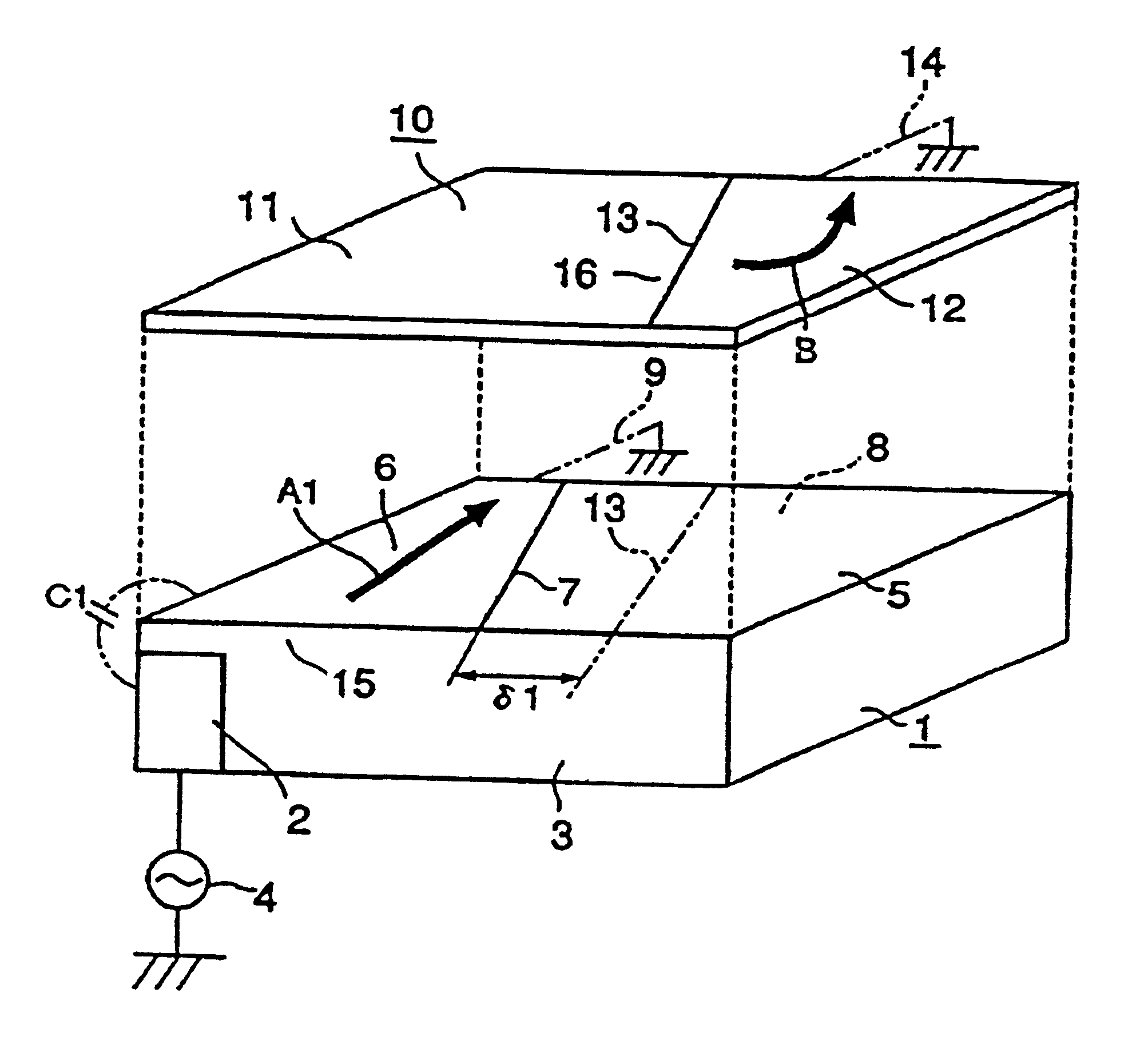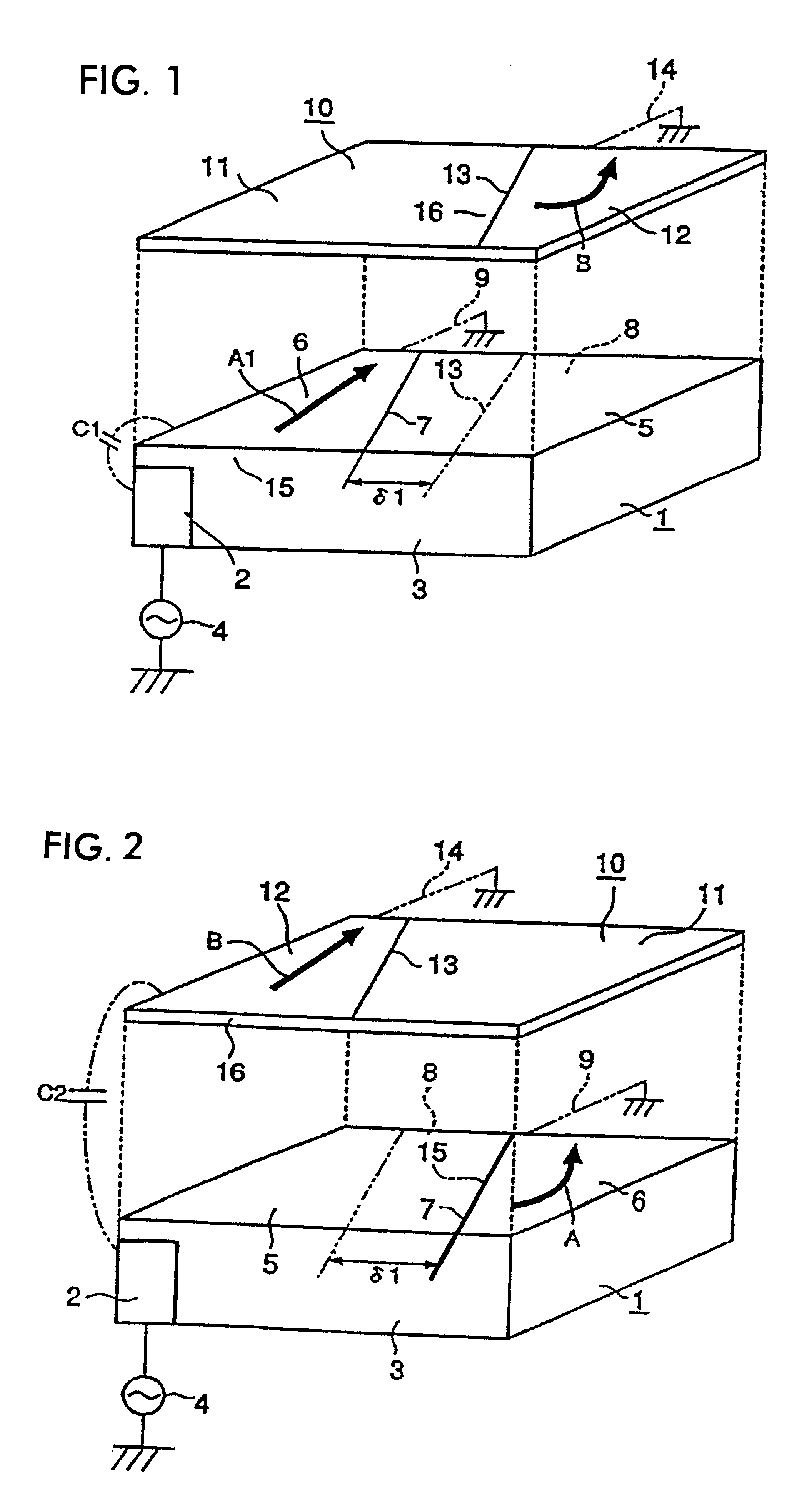Surface-mounted antenna and communication apparatus using same
a technology of communication apparatus and antenna, applied in the structure of individual energized antenna arrays, resonant antennas, radiating elements, etc., can solve the problems of signal interference between radiation electrodes, inability to meet the demands of high performance and miniaturization, and difficulty in achieving the wide frequency bandwidth of antennas
- Summary
- Abstract
- Description
- Claims
- Application Information
AI Technical Summary
Benefits of technology
Problems solved by technology
Method used
Image
Examples
first embodiment
FIG. 1 shows the structure of the main part of a surface-mounted antenna according to the present invention. In this figure, a base dielectric substrate 1 is formed of a material having a high permittivity such as ceramic or resin, and has a rectangular (rectangular parallelepiped) configuration. On the bottom of the base dielectric substrate 1, a grounding electrode (not shown) having a wide area and a feeding connection electrode 2 insulated from the grounding electrode are disposed. The feeding connection electrode 2 extends from the bottom of the base dielectric substrate 1 to the front surface 3 thereof. The feeding connection electrode 2 is connected to a signal source 4.
The upper surface of the base dielectric substrate 1 is denoted by reference numeral 5. A trapezoidal first radiation electrode 6 is formed of a conductive material in the left-half region of the upper surface 5 of the base dielectric substrate 1. An edge 7 of the trapezoidal electrode 6 comprises an oblique l...
third embodiment
In the third embodiment, a feeding signal supplied from a signal source 4 is supplied to the first radiation electrode 6 of the base dielectric substrate 1 via the capacitance C1, and then is supplied to the second radiation electrode 12 of the base dielectric substrate 1 via the capacitance of the gap .delta.1. Meanwhile, the feeding signal from the first radiation electrode 6 of the base dielectric substrate 1 is supplied to the first radiation electrodes 6 of the multi-layer dielectric substrate 10 via the capacitance C3, and then, is supplied from the first radiation electrode 6 of the multi-layer dielectric substrate 10 to the second radiation electrode 12 thereof via the capacitance of the gap .delta.2.
In each of the first and second radiation electrodes 6 and 12 of the base dielectric substrate 1 and the multi-layer dielectric substrate 10, a current flows from the short edges (conducting electrodes 9 and 14) to open ends 15 and 13. Then, the first radiation electrode 6 of th...
fifth embodiment
Similar to the other embodiments, in the fifth embodiment, by adjusting the gaps .delta.1, .delta.2, and .delta.3 between the radiation electrodes of the individual layers and the gaps angles .theta. as needed, directions in which the radiation electrodes of the individual layers vertically adjacent excite can be adjusted in different directions, that is, in non-parallel directions. In addition, by selectively changing the permittivity of each of the multi-layer dielectric substrates 10a and 10b, isolation between the vertically adjacent upper and lower layers can be adjusted.
Furthermore, in this embodiment, by setting the permittivity of each of the multi-layer dielectric substrates 10a and 10b to be higher than the permittivity of the base dielectric substrate 1, electric fields are concentrated on the multi-layer dielectric substrates 10a and 10b so that the band of a set frequency can be widened. Particularly, by maximizing the permittivity of the top multi-layer dielectric subs...
PUM
 Login to View More
Login to View More Abstract
Description
Claims
Application Information
 Login to View More
Login to View More - R&D
- Intellectual Property
- Life Sciences
- Materials
- Tech Scout
- Unparalleled Data Quality
- Higher Quality Content
- 60% Fewer Hallucinations
Browse by: Latest US Patents, China's latest patents, Technical Efficacy Thesaurus, Application Domain, Technology Topic, Popular Technical Reports.
© 2025 PatSnap. All rights reserved.Legal|Privacy policy|Modern Slavery Act Transparency Statement|Sitemap|About US| Contact US: help@patsnap.com



